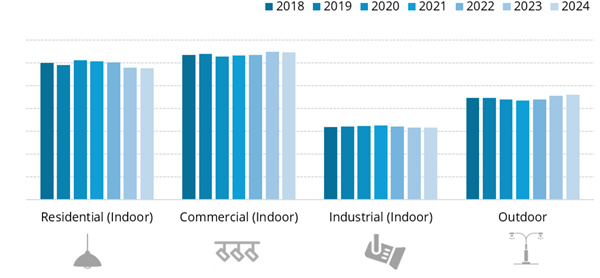Global Lighting Market Outlook Highlights Slowdown in 2024 with Recovery Forecast for 2025-2027, Driven by Professional Indoor and Outdoor Lighting Segments
Lighting: World Market Outlook for LEDs and Lighting Fixtures provides an in-depth analysis of the global lighting sector, with 2018-2024 production, consumption, and international trade data for 70 countries and 2025-2027 lighting fixtures market forecasts by geographical area and segment.
Global lighting fixtures market trend by segment, 2018-2024
After a post-pandemic period of extraordinary growth, the global lighting market has started to slow down. Although a further slight decrease was registered in 2024, the analyst estimates that the lighting market should recover in 2025 and record higher growth rates from 2026 onwards, on a world level. The US is the largest lighting fixtures consuming country, accounting for more than 20% of global consumption, followed by China and Japan.
Among the different main segments of destination, Professional indoor lighting currently represents almost 50% of the total lighting market share and Outdoor lighting is outperforming with a growth rate above the market average.
KEY GROWTH DRIVERS IN THE WORLDWIDE MARKET FOR LIGHTING
- The first part of this study offers an overview of the world lighting market size for 2024, including lighting fixtures and lamps, comparing the evolution of the residential and professional segments.
- The activity trend and forecast part shows the lighting fixtures market performance for the years 2018-2024 highlighting the two major market segments: residential/consumer lighting and professional lighting, indoor and outdoor.
- Data for lighting fixtures production, consumption, and international trade are analysed with a comparison by selected key macro indicators. Ranks of the leading companies by market share, sector concentration, and relevant M&A operations over the last years are also reported.
- This chapter also provides market development forecasts for the period 2025-2027 at a World level, by region, and by segment.
- The international trade part analyses the world trade of lighting fixtures and lamps, with export and import data by country for the period 2018-2023.
MARKET STRUCTURE: LIGHTING SEGMENTS AND DESTINATIONS
The global lighting fixtures market is also broken down by segment:
- Consumer/Residential indoor lighting
- Commercial indoor lighting
- Industrial indoor lighting
- Outdoor lighting
This chapter also estimates the current world lighting fixture sales by main destination segments, with 2025-2027 forecasts.
LEDS AND CONNECTED LIGHTING
This report also deals with:
- LED lighting evolution and its incidence over the global lighting fixtures and lamps market, providing details by segment and geographic region in the period 2018-2024. Estimated sales volume (units) of LED lamps and luminaires by product and by price range are also provided. LED lighting global market forecasts are provided for 2025-2027.
- Connected lighting evolution for the period 2018-2024, with the incidence by segment.
LIGHTING FIXTURES MARKET COMPETITIVE LANDSCAPE
- This study offers insights into the leading lighting players by the main destination segments and by the main geographic regions, with detailed tables showing sales data and market shares of selected lighting companies and short profiles of the main players.
- For a sample of around 100 global companies active in the lighting sector, the report offers an analysis of selected key financial data, main profitability ratios (ROA, ROE, EBIT, and EBITDA), and indicators related to the equity and financial structure of the considered sample of companies, for the time frame 2019-2023.
Over 300 companies are considered in this report.
DISTRIBUTION CHANNELS ACTIVE ON THE WORLD MARKET FOR LIGHTING FIXTURES
Overview of the main distribution channels active on the world market for lighting fixtures. The analysis of the distribution system is organized by the following channels:
- Contract/Projects
- Specialists Lighting Stores
- Lifestyle retailers (furniture & furnishings chains, furniture stores, department stores)
- Electrical wholesalers
- DIY Stores
- E-commerce
COUNTRIES AND GEOGRAPHIC REGIONS CONSIDERED
70 countries grouped by 6 macro geographic regions, based on the following classification:
- North America: Canada, Mexico, United States (3 countries)
- South America: Argentina, Brazil, Chile, Colombia, Venezuela (5 Countries).
- European Union (27) + Norway, Switzerland and the United Kingdom: Austria, Belgium (including Luxembourg), Bulgaria, Croatia, Cyprus, Czech Republic, Denmark, Estonia, Finland, France, Germany, Greece, Hungary, Ireland, Italy, Latvia,
- Lithuania, Malta, Netherlands, Poland, Portugal, Romania, Slovakia, Slovenia, Spain, Sweden, plus Norway, Switzerland and the United Kingdom (Europe 30 Countries).
- Other Europe: Belarus, Kazakhstan, Russia, Serbia, Türkiye, and Ukraine (6 countries).
- Asia and Pacific: Australia, China, India, Indonesia, Japan, Malaysia, New Zealand, Philippines, Singapore, South Korea, Taiwan, China, Thailand, Vietnam (13 countries).
- Middle East and Africa: Algeria, Bahrain, Egypt, Israel, Jordan, Kuwait, Lebanon, Morocco, Oman, Qatar, Saudi Arabia, South Africa, Tunisia, United Arab Emirates (14 countries).
THIS RESEARCH AIMS TO ANSWER THE FOLLOWING QUESTIONS:
- How big is the global lighting market in 2024? What are its prospects and forecasts?
- What are the world’s largest lighting fixtures consuming countries?
- What are the main target segments of global lighting and their trends?
- What are the dynamics of the world lighting fixtures trade?
- What are the major players in the global lighting fixtures market?
- What is the current LED incidence within the lighting market?
- How are technologies, such as LEDs and connected lighting, evolving in the global lighting market?
Selected Companies
Among the considered companies: Acuity Brands, Artemide, Bajaj, Delta Light, Eclatec, Endo, Fagerhult, Flos, FSL Lighting, Ikea, Ledvance, Leedarson, Linea Light, Opple, Panasonic, Pelsan, RangDong, Schreder, Signify, SLV, Tospo, Trilux, Unilumin, Yankon, Zumtobel
Table of Contents
Companies Mentioned (Partial List)
A selection of companies mentioned in this report includes, but is not limited to:
- Acuity Brands
- Artemide
- Bajaj
- Delta Light
- Eclatec
- Endo
- Fagerhult
- Flos
- FSL Lighting
- Ikea
- Ledvance
- Leedarson
- Linea Light
- Opple
- Panasonic
- Pelsan
- RangDong
- Schreder
- Signify
- SLV
- Tospo
- Trilux
- Unilumin
- Yankon
- Zumtobel









